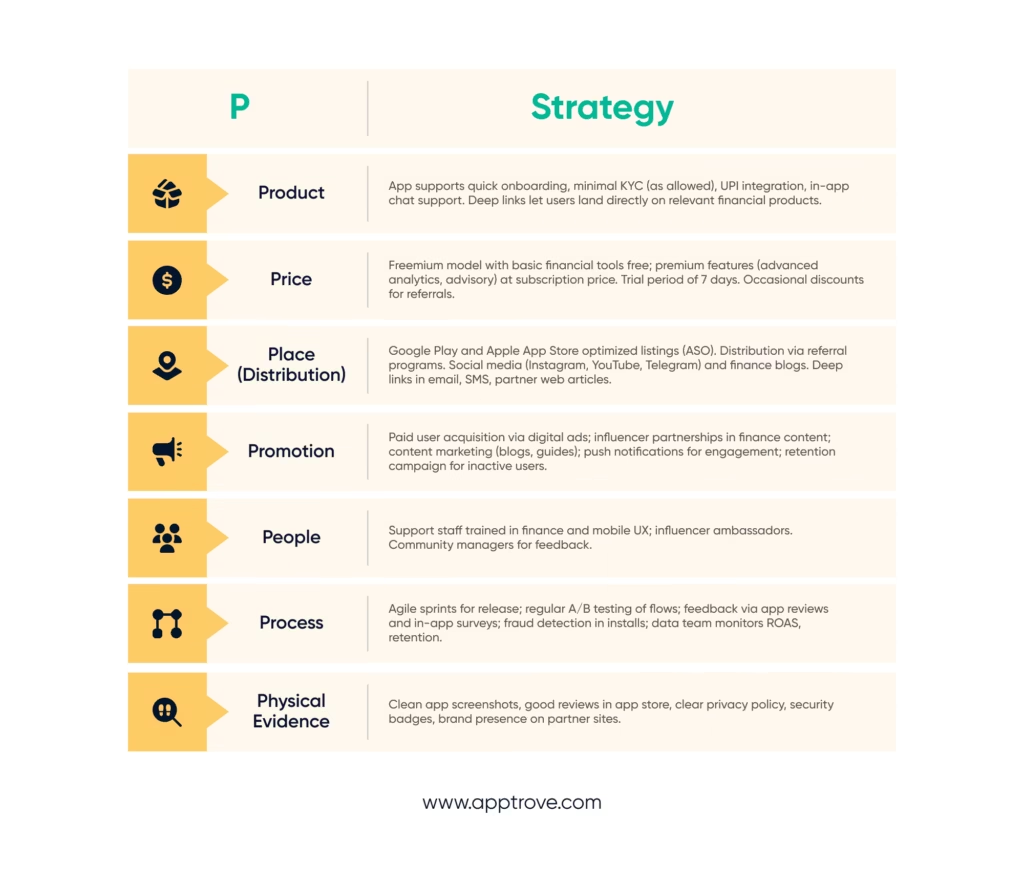Mobile Marketing Mix in 2025: Strategies, Challenges, and How Apptrove Helps You Win
In 2025, over 70% of the time dedicated to digital media occurs on mobile devices, yet a mere 35% of ad budgets are allocated on mobile-first strategies. This disparity indicates a tremendous opportunity for marketers who can optimize their mobile marketing mix. Mobile users are everywhere and they expect seamless experiences, personalized messaging and frictionless journeys. If your marketing mix isn’t optimized for mobile, you are leaving return on investment on the table. In this blog post, we will dive in to defining what a mobile marketing mix is, why it matters, the components of a mobile marketing mix, how to build one, and how Apptrove’s platform can help you get it right.
What is “Mobile Marketing Mix”?

The “marketing mix” is one of the oldest and best-known frameworks in marketing. It originally consisted of the 4 Ps: Product, Price, Place, Promotion. In service- and experience-based marketing it expanded to include additional Ps such as People, Process, and Physical Evidence. In the case of mobile marketing, each P needs to be adapted to the unique conditions of mobile: different user behaviors, operating system constraints, privacy regulations, shorter attention spans, hardware limitations, etc. Therefore, the mobile marketing mix is a modified version of the classic marketing mix designed for a mobile-first (or arguably mobile significant) strategy.
Why the Mobile Marketing Mix Matters
Here are the important facets of mobile marketing mix which tell why its important:
- Mobile-first user behavior: more & more people are primarily using apps and the mobile web to conduct all of their tasks, from shopping to banking.
- Competition is fierce: thousands of apps vie for attention in each category and to break through your marketing mix must be sharp.
- Data privacy & OS changes: iOS changes (like SKAdNetwork for attribution), Android’s evolving policy, etc., cause you to rethink how you are measuring, distributing, and promoting.
Here’s one example of what proper mobile measurement can do: Apptrove’s case studies show in the real world, “Vaaree Achieved a 30% Conversion Surge with Apptrove,” when mobile measurement & optimization tools are used properly.
Components of a Mobile Marketing Mix
Here are the core elements (Ps) adapted to mobile. For each, we’ll discuss how they apply to mobile apps or mobile web, and then what levers you can pull.
| Element | What It Means in Mobile Context | Key Levers / Strategies |
| Product (or Service) | The app (or mobile web service) itself: its features, usability, performance, UI/UX, how it solves a user problem. Mobile products must be optimized for device limitations, OS versions, connectivity. | • Prioritize smooth onboarding & performance. • Feature-set aligned to mobile user pain points (e.g. push notifications, offline usage, location services). • Regular updates. • Deep linking so users land in-context. Apptrove’s Deep Linking tools help here. |
| Price | Not just monetary price: cost of install (data, battery, time), in-app purchases, subscription models, freemium vs paid, etc. For distribution, there may also be cost considerations in ad spend. | • Choose pricing model suited to your audience. • A/B test subscription tiers vs one-time purchase. • Use promos (discounts, trials) wisely. • Monitor Customer Acquisition Cost (CAC) vs Lifetime Value (LTV). Apptrove offers tools for user acquisition and insights into LTV. |
| Place (Distribution / Access / Channels) | How & where users find your app: App Store / Play Store discoverability; social media; web ads; affiliate links; organic channels; owned media. Also includes how users are delivered inside the app (e.g. deep links, push notifications). | • App Store Optimization (ASO). • Leverage owned channels (email, push). • Use affiliates, referral programs. • Deep linking across multiple sources: email, QR, web, SMS. Apptrove’s Unilinks help unify journeys. |
| Promotion | Advertising, content, social media, influencer partnerships, push notifications, app store promotion, retention campaigns. In mobile, you often need to balance acquisition vs retention vs engagement. | • Targeted ad spend with attribution. • Use segmentation to send relevant messages. • Retarget dormant users. • Promote via multiple channels (paid & organic). • Use analytics to measure which creatives / channels perform best. Apptrove’s real-time campaign dashboards help. |
| People | Every user touchpoint: customer support, user interface, marketing team, sales/partnerships. Also includes who represents the brand and how (influencers, ambassadors). | • Train teams to be mobile-centric. • Empower support via chat, feedback loops. • Use influencers who align with mobile audiences. • Empathize with users: performance, UX, privacy concerns. |
| Process | How your team delivers the app, pushes updates, handles feedback, handles marketing campaigns. For example, how quickly you can iterate, collect data, measure, and optimize. | • Agile methodology for feature releases. • Loop feedback via analytics & in-app events. • Build pipelines to detect fraud, bad traffic. • Use tools that give real-time or near real-time insights and attribution. Apptrove offers real-time insights and ROAS tracking. |
| Physical Evidence (or Supporting Evidence) | For mobile apps this can mean the app store listing (screenshots, reviews), presence on social proof, UI design, branding, trust signals, privacy compliance, etc. | • High-quality app store creative assets, clear reviews, ratings. • Mention trusted badges, privacy, security. • Strong brand identity • Consistent UX design, polish. |
How to Construct a Strong Mobile Marketing Mix
Putting the components together effectively is what counts. Here are steps and best practices.
Define Clear Objectives
And what are you attempting to accomplish? Increased apps installs, app retention, in-app purchases, increased engagement, or all of them? Get specific: use specific measures, such as install volume, 30-day retention rate, ARPU, ROI.
Segment Your Audience
Not all users are the same. Take up demographics, behavior, geographies, previous actions. Audience Segmentation tools are offered by Apptrove to assist you in cohorting high-value.
Map the User Journey
From discovery → install → onboarding → action (purchase, engagement, retention). Identify drop-off points; use tools like deep links to make journeys smoother. Apptrove’s Deep Linking helps make sure users land in the right part of the app.
Choose Channels & Promotional Mix
Decide on a budget: paid adverts, influencer, ASO, organic reach. Determine the amount of money to allocate to each channel, experiment with creatives. Check fraud detection applications to make sure that you are not paying money to buy a fake install. Apptrove offers Fraud Prevention among the partners and channels.
Pricing Strategy
In-app purchases or subscriptions: free trial, freemium, tiered plans, etc. What can people pay and what do your competitors do. Monitor free to paid segment conversion.
Optimize for Platform & Device
iOS vs Android vs mobile web. All of them have varying limitations: OS policies (privacy, attribution), hardware, screen sizes. As an illustration, SKAdNetwork in iOS and its impact on attribution: you will have to use tools that achieve SKAN analytics. Apptrove is a supporter of SKAN analytics.
Monitor, Measure, Iterate
Measures: installs, retention, engagement, LTV, ROAS, churn. Measures partner/channel performance. Use attribution windows. Detect fraud. Incorporate mix according to what works. The platform of Apptrove includes real-time dashboards, partner performance indices, custom reports.
Ensure Privacy & Compliance
Always important in mobile: data privacy, permission, OS requirements. Build trust. Ensure that your product evidence (user security, privacy policies), is visible.
Real-World Stat & Example
- One example of this is the recent case study on Apptrove: Vaaree in which a 30% conversion surge was realized through better measurement and optimization.
- Another stat: Apptrove has more than 500 global partners, which allows the partner to reach widely and cover various channels in the partner ecosystem.
These demonstrate that performance can be boosted greatly with the proper combination (particularly measurement, attribution, deep linking, and fraud prevention).
Challenges Unique to Mobile Marketing Mix
- Attribution complexity: Attributing post-install behavior and installs is more complicated with privacy controls, device restrictions and regulations such as SKAdNetwork.
- Fragmentation: Dissimilar OS versions, device type, screens, territories. Means more testing.
- Attention span of users: The users of mobile apps might switch or even remove at the earliest if the onboarding or UX is not satisfactory.
- Ad fraud: Fraudulent installs, clicks injection.
- Budget limitations: Mobile may need huge amount of money to acquire users, yet in case of poor retention, then ROI is compromised.
Sample Mobile Marketing Mix Plan
Here is a hypothetical plan for a consumer finance app launching in India:

Conclusion
A good mobile marketing mix is created by strategizing each of the Ps so that they fit the mobile context. It is the coordination of product attributes, pricing policies, sales channels, marketing, staff, procedures, and data to bring not only consumers, but high-value loyal users on a large scale.
Apptrove can play a critical role in this undertaking with its assortment of tools – deep linking, SKAN analytics, audience segmentation, fraud prevention, real-time dashboards. Apptrove makes your mix adaptive, your decisions more visible and your ROI more predictable when you use Apptrove as your measurement backbone. Unless you want to expand your app successfully and sustainably in the mobile-first world, it is not optional to learn the mobile marketing mix. It’s essential. And Apptrove aids you in departing.

FAQs
1. What is a mobile marketing mix and how is it different from the traditional marketing mix?
The mobile marketing mix takes the traditional 4Ps – Product, Price, Place, and Promotion – and adjusts it for mobile-first strategies. The mobile marketing mix uses similar marketing concepts but incorporates different elements. For example, the mobile marketing mix accounts specifically for shorter attention spans of audiences, app store discoverability, in-app user journeys, and new privacy regulations. The mobile marketing mix is a key tool for marketers looking to create mobile campaigns and improve perceived ROI.
2. Why is optimizing the mobile marketing mix important for app marketers?
It’s important to get as much as you can from the mobile marketing mix because mobile device users are increasingly spending 70% or more of their digital media time on mobile devices. The critical reality is that despite the growing significance and direct impact of mobile devices, mobile marketing budgets are typically behind. A proper mobile marketing mix facilitates the best user experience, personalized messaging, and accurate attribution through mobile measurement principles. This assists app marketers can ultimately will define better user acquisition, user retention, and overall return on ad spend (ROAS).
3. What are the main components of a mobile marketing mix strategy?
The key components of a mobile marketing mix include:
1. Product: Mobile app features, UI/UX, and performance.
2. Price: Subscription models, freemium tiers, and in-app purchases.
3. Place: App Store Optimization (ASO), distribution channels, and deep linking.
4. Promotion: Paid ads, influencer marketing, push notifications, and retention campaigns.
These elements, combined with People, Process, and Physical Evidence, create a mobile-first strategy that drives growth in competitive app markets.
4. How can mobile attribution platforms improve your mobile marketing mix?
Mobile attribution platforms are critical to mobile marketing mix optimization through accurate tracking and reporting of installs, user journeys, and campaign performance. They assist app marketers in identifying high-value user segments, measuring ROI, and detecting ad fraud. Platforms like Apptrove offer interactive dashboards and analytics appropriate for all your mobile marketing mix decisions, providing a data-centric approach to mobile marketing, and adapting to evolving OS factors like SKAdNetwork adjustments.
5. What are the biggest challenges in building a successful mobile marketing mix
There are a few challenges involved in putting together a mobile marketing mix suited for your business. These challenges stem from privacy regulations that make attribution complex, platform fragmentation across iOS and Android, short user attention spans, ad fraud, and budget allocation. In order to address these challenges, brands need user-level mobile app attribution tools, sophisticated audience segmentation, and ad fraud prevention solutions to accomplish actionable measurement and more effective ROI.
from Apptrove https://apptrove.com/mobile-marketing-mix-strategies-insights/
via Apptrove
Comments
Post a Comment